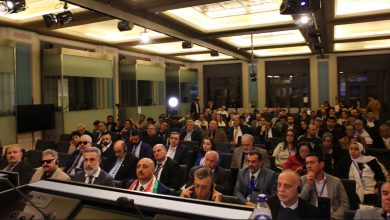
A study that cuts the tongues of the Persians in claiming the ownership of the Arabian Gulf
With the increasing claim of the Iranian occupation state to its ownership of the Arabian Gulf, so that the term “Persian Gulf” has become widespread in some of the media loyal to it or on the tongues of criminals from its militia in the Middle East, and this prompted the occupied Arab Ahwaz website to shed light on an old study confirming the lies of Iranian occupying country.
A study confirmed that the Iranian position regarding the designation of the “Arabian Gulf” raises a sharp media controversy, and that this position is not limited to merely insisting on branding the Gulf with the “Persian” identity only; Rather, it goes beyond that to include national dimensions and political implications that revolve around the pursuit of regional hegemony.
The study, issued by the Bahrain Center for Strategic, International and Energy Studies, and prepared by Dr. Bashir Zain al-Abidin, and entitled “The Arabian Gulf and Dimensions of Naming”, considered that the Arab position towards this controversy should not stop at discussing the verbal name of the Arabian Gulf, but rather should be based on the fact That Gulf Arabism is an essential component of the regional identity of the Gulf population as a whole.
The study stated that the waters of the Gulf were called by several names throughout different ages, and that many geographers and historians in ancient times called it the “Arabian Gulf” due to the dominance of the Arab element over its ports and islands, and among the most prominent of these travelers and geographer Strabon, and the Roman historian Pliny.
She pointed out that many historical and geographical works, as well as maps that appeared during different eras, especially during the period from (1478-1861), the majority of them confirm the Arab identity of the Gulf, evidenced by the fact that the vast majority of the names that geographers and travelers used to use, such as: The “Arabian Gulf”, “the Gulf of Iraq”, “the Gulf of Basra”, “the Gulf of Oman”, “the Basra Sea”, and the “Qatif Sea” confirm the Arab identity of the Gulf.
The study found that many modern European sources and maps that use the name “Arabian Gulf,” confirming that in 1990 Jean-Pierre Vignon, professor of the National Institute of Oriental Languages and Civilizations in Paris, published a study in the French newspaper “Le Monde” in which he emphasized the name of the Arabian Gulf, based on the map of “Locanor” dating back to the end of the sixth century. Ten, which bears the Latin appellation “Sinus Arabikos”, which means “the Arabian Sea”.
The French researcher said: “I found more than one document and map in the National Library in Paris that conclusively proves the name “Arabian Gulf” (…) and that the name “Persian Gulf” recently circulated among some European geographers came as a result of political orientations by some colonial powers in the nineteenth century.
The study continued its political and historical analysis and said: There are attempts to neglect the Arab element in the historiography of the events that occurred in the region, ancient and modern, stressing that there are many modern and contemporary historical studies that did not address the Arab political entities that dominated the two shores of the Gulf, despite the fact that the history of Arab hegemony On the eastern shores of the waters of the Gulf, it dates back to the beginning of the fourth century AD, and the Arab presence has continued to this day, and that Western travelers spoke at length about the domination of the Arabs over the navigational movement in the Arabian Gulf, most notably the traveler Carsten Niebuhr, who spoke about the Arabism of the Gulf in the eighteenth century.
The study noted that there is a dearth of scientific research that investigates the roots of the Arab presence in the ports and islands of the Arabian Gulf, and that scientific institutions should publish more historical studies dealing with this subject, with the aim of consolidating this presence as part of the cultural construction of the Gulf Cooperation Council countries. .
And added that the tendencies of Iranian hegemony over the Gulf appeared in its official positions in an alarming way since 2004, when the National Geographic Foundation wrote the name “Arabian Gulf” in its new atlas, and indicated that there was a dispute over the three occupied Emirati islands, which prompted Tehran at the time to Banning the Foundation’s publications and maps in Iran, citing what it called the “Persian” historical identity of the Gulf.
In the same and subsequent period, especially in 2006 and 2008, numerous positions and articles appeared in Iranian official newspapers claiming that Tehran had the right to control the rest of the Arabian Gulf, and that its western coasts were affiliated with it before Islam, and that the name “Persian Gulf” is the only name given to it. The Arabian Gulf, denying the existence of any other designation, which confirms that the official position of Iran today deals with the problem of the name of the Gulf from a nationalist standpoint that seeks to abolish any other identity in the Arabian Gulf.
The study monitored many sources that confirm that the inhabitants of the coasts of the Arabian Gulf and its islands go back to Arab origins that migrated from the Arabian Peninsula to its outskirts, and that the Persians by their nature find it difficult to adapt to sea life compared to the Gulf Arabs who settled the Gulf coasts, and the Arabs maintained maritime sovereignty. In the Arabian Gulf throughout the period from the eighth century AD to the nineteenth century AD.
The study quoted European researchers such as the English historian Roderick Owen in his book: “The Golden Bubble: Documents of the Arabian Gulf,” and the British historian Arnold Wilson, as saying: “The actual Persian control did not exist on the eastern shores of the Gulf, but the influence of the Arabs was since the time of Sabor.” The second was in the fourth century AD, and it continued after the establishment of the Islamic state, and until an advanced period from the present time.”
The study considers that there are strategic considerations that push Iran to claim another name for the Gulf, and among these considerations is the chauvinistic national dimension surrounding the issue, and its tireless attempts to confirm its recognition as a major regional power, and seek to play a security role in the region even at the expense of others, noting that Iran is a state It is “semi-closed” surrounded by mountains and deserts from the north, east and west. Therefore, it depends in its contact with the outside world on its Gulf view.
She added that the waters of the Persian Gulf are the main crossing point for Iran’s imports and its oil, which constitutes 80% of its revenues, and the main source of its foreign currency resources, and that Tehran does not want to irritate the major powers in Asia such as India, China and Russia if they adopt an expansionist policy in the eastern or southern regions of their country. In addition, of course, insisting on another name for the Gulf greatly relieves the pressure and internal tension from which Iran is sluggish by doing many things that are no longer hidden from anyone.
The study concluded by emphasizing that Iran’s raising of the issue of the name of the Gulf in the current period represents a great danger to Arab awareness, as both Islam and Arabism are the main pillars of the components of the national identity of the Gulf Cooperation Council countries. Therefore, these countries must support serious scientific research aimed at To consolidate the Arab identity.




